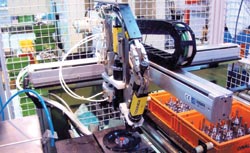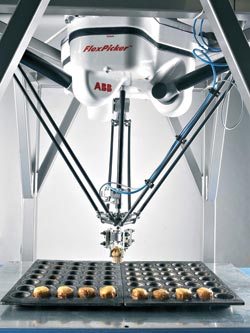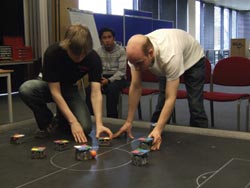Equipping a robot with vision dramatically enhances its capabilities, enabling it to identify different parts, to handle products randomly arranged on the conveyor and to combine product inspection with manipulation. The main robot manufacturers now build vision capability into their controllers.
For example, Fanuc Ltd. of Oshino-mura, Japan, incorporates iRVision hardware in its R-J3iC controller, enabling users to integrate vision simply by plugging a camera and cable into the main board. Stäubli Robotics of Faverges, France, has a partnership agreement with Cognex Corp. of Natick, Mass., USA, delivering systems such as the RX60 robot with PatMax vision system at Modgal Metal Ltd. of Rosh Pina, Israel. The robot inspects parts and feeds them to a tapping machine, coping with parts of different shapes and sizes for cast iron pipe fittings.

A Cartesian robot uses two cameras to inspect parts for fuel injection systems. Courtesy of TM Robotics (Europe) Ltd.
Toshiba Machine has a large range of Cartesian robots, in which Toshiba software controls linear actuators set at right angles, for tasks involving precise movements within a rectangular work envelope. These include assembly, packaging and pick-and-place applications.
Spanish automotive manufacturer Dinalot uses a Cartesian robot with two Cognex vision sensors for 100 per cent inspection of the tapped and countersunk holes in the five types of metal discs for fuel injection systems. It takes nine seconds to check each part and has greatly improved the quality of shipped parts.
TM Robotics is supplying another customer with a vision-integrated robot system that finds the position and orientation of tubes and applies bar-code labels to each one, for product traceability.

The unusual design of the FlexPicker robot makes it very fast and accurate and particularly suitable for food-handling applications. Courtesy of ABB Robotics.
High-speed food picking
Over the past decade, the FlexPicker robot from ABB Ltd. of Zurich, Switzerland, has established itself in food and pharmaceuticals, picking pastries, bread and croissants, vaccines, tissues and mascara brushes. Its delta design achieves 0.1-mm precision and up to 150 picks per minute, while PickMaster 3.10 software controls multiple cameras and robots. The software divides the task between the robots while tracking the products on the conveyor. This leads to spectacular packaging systems: At Dulcesol bakery in Spain, a line of six IRB 340 FlexPickers handles small croissants at 1020/min; Italian pizza maker Panidea uses two vision-equipped robots, each delicately handling four pizza shapes at up to 80 items per minute.
A vision-equipped robot automatically inspects each product before it picks it, so if the product is out of tolerance, the robot passes over it, sometimes allowing recycling of the rejected items. For example, at Ilchester Cheese Ltd. in the UK, two FlexPicker robots check the height of each block of cheese before picking and packing. Any out-of-tolerance blocks return to the extruder to be formed into new blocks, increasing the overall yield of the production line. ABB has just launched its second-generation FlexPicker, the IRB 360, which is even faster and has integrated vision software.
Student projects
Students find vision and robotics an inspiring combination. Robot football provides challenging and multidisciplinary project work for engineering students, who use mechanical, electronic, vision and software skills to build and control the 75-mm-cube mobile robots. A camera over the pitch images the ball and robotic players, and software works out how best to move the players to take the ball to the goal or defend against the unpredictable moves of the opposing team.

A spectator in the background watches engineering students Christopher Payne (left) and Michael Tandy (right) position robotic football players for the kickoff in the UK Robot Football Championships, 2008. Courtesy of Warwick Mobile Robotics, University of Warwick, UK.
The University of Warwick in the UK has fielded a robot football team and hosted the UK finals frequently over the past few years. But in 2008/9, final-year students in the master’s in engineering programme at Warwick Mobile Robotics are concentrating on RoboCup Rescue, competing in the European leg of the competition in April. They are developing a semiautonomous search-and-rescue robot for earthquake disaster zones, with visible and IR cameras to find victims.